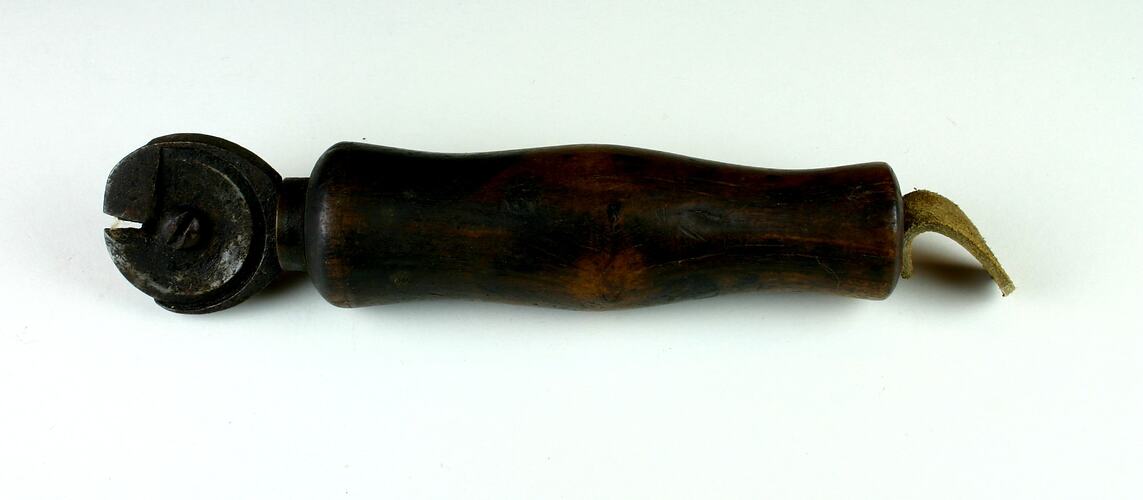Summary
This wooden handled circular welt cutter was an important tool within Stanio Fancoff's shoemaking kit. The welt is a leather strip sewn to the shoe's upper and insole, in which the shoe's external sole may be attached. If after construction, the well protruded beyond the shoe line, similarly to a knife, this circular welt cutter would be used to reduce its sizing and give the shoe a uniform appearance. When used by experts such as Stanio, these particular tools were considered superior to the traditional welt trimming knife or rasp.
Stanio Ivanoff Fancoff was born in 1908 in Bojentsi, a small village in Bulgaria. At age 11, Stanio left home to learn the shoemaking trade. In 1929, he immigrated to Melbourne, settled in Fitzroy and began to work for the V.G. Zemancheff & Sons basket shoe factory in South Melbourne. In1936, he married Dorotea Georgi Touzou who had recently arrived in Australia. Around this time, Stanio set up his own shoemaking business from home, with Georgi, her cousin and sister weaving the shoes which he then assembled. Select shoe samples were then taken to Sydney and Tasmania for sale. In 1942, Georgi and Stanio moved to Broken Hill for Georgi's health; there daughter Nancy was born and Stanio set up a shoe shop/factory. In 1945, Georgi died and by 1950 Stanio and Nancy had moved to Adelaide where he again opened a shoemaking business and shop. He passed away in 1978, having been in the shoemaking business for 59 years. This collection documents his migration and working life experiences.
Physical Description
This wooden handled circular welt cutter shows distinct signs of aging through extensive corrosion and handle wear. The wooden handle is light in colour but has a covering of darkness possibly varnish as encountered during its working life. The handle's is inscribed with a singular line that encircles the top portion. A medium tanned leather strip with a purpose made button hole is singularly tacked to the handle's base, while a neck band encircles the handle/tool head join. The metal tool is cast in one piece, in which a rebate sits across the circular head with a plate screwed onto it.
Significance
This collection is significant in documenting a small migrant business as well as the fashion of a particular period. It is well provenanced and charts the application of trade skills in a new country. It also illustrates the stages of hand shoe manufacture from the 1930s, demonstrating the enduring nature of the tools and patterns that were used.
More Information
-
Collecting Areas
-
Acquisition Information
Donation from Nancy Vasileff, 21 Mar 2007
-
Past Owner or User
-
Classification
-
Category
-
Discipline
-
Type of item
-
Overall Dimensions
175 mm (Length), 35 mm (Width), 30 mm (Depth)
-
References
R.A. Salaman, 'Dictionary of Leather-working Tools c.1700-1950 and Tools of Allied Trades,' London: George Allen and Unwin (Publishers) Ltd, 1986 [Section 2: Boot and Shoe Maker pp18-185]. John Peacock. 'Shoes, The Complete Sourcebook,' London:Thames & Hudson Ltd, 2005. NAA holds file (online) on Vasil George Zemancheff, Fancoff's employer
-
Keywords
Boot & Shoemaking, Bulgarian Communities, Bulgarian Immigration, Immigration, Small Businesses, Tools



